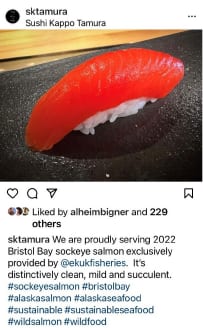
sushi
category report
Sushi trends
and industry complications
Sushi trends include local seafood, layers of texture and salmon-topped sushi.
By Sammy Bredar
Associated Editor
Chef Taichi Kitamura, executive chef and owner of Sushi Kappo Tamura in Seattle, Washington, discussed the current sushi market, focusing on sushi trends and industry complications.
For creative sushi trends, Kitamura offers his insights regarding two current trends. He said sushi chefs want to know about the full origins of the sushi — all the way from water to table — and that sushi chefs want to share these origins. Another trend that Kitamura points out is the emergence of more local seafood. Kitamura said that high import costs from Japan are leading sushi chefs toward this trend.

“There are items like herring, sardine, flounder, sole, mackerel and chum salmon on the Japanese fresh sheet at prices as high as $35 per pound,” Kitamura said. “These items are all underutilized, underpriced or not available in the traditional American market.”
In terms of creative trends in sushi, The Norwegian Seafood Council said Chef John Livera is trying layers of texture in sushi. “In his recipe for Crispy Norwegian King Crab Roll, Chef John adds hothouse cucumber for a bit of crunch inside the roll to juxtapose the sweet, succulent Norwegian red king crab legs, and then fries the entire roll in tempura batter for extra crunch.”
Market complications like inflation and supply chain issues have greatly affected the food industry, and Kitamuri said sushi is no exception. Despite ongoing industry complications, Kitamura remains optimistic about the availability of fish for sushi.
“At Sushi Kappo Tamura, we’ve focused our current menu on other seafood that is more available, and are still able to offer a couple of menu items, sourcing red crab,” Kitamura said. “However, alternate species from Alaska and in the Pacific Northwest may open seasons in the new year, allowing sushi products to use more crab as it becomes available.”

Alaska’ crab season has closed, and though Kitamura said that species like snow and king crab are less available, he is confident that there is ample seafood available for consumers.
While supply chain issues have affected some seafood species, there are plenty of high-quality, sustainable fish available in the market, he said.
“Bristol Bay sockeye salmon out of Alaska just had the highest harvest on record, making it easy to access wild, sustainable sockeye salmon right now,” Kitamuri said.
Salmon is a popular fish in sushi right now, according to The Norwegian Seafood Council. “Salmon is now the preferred sushi topping in 17 out of 20 markets, with 64% of consumers overall citing salmon as their top choice when it comes to sushi, according to a Norwegian Seafood Council global survey that examined the seafood consumption habits of more than 20,000 consumers across 20 key markets.
The Norwegian Seafood Council notes that in the 1980s, Norway was the first country to use salmon in sushi products, and Norway is now the largest global exporter of salmon. Norway’s presence in the salmon industry positions them as a strong player in the sushi industry, too.

